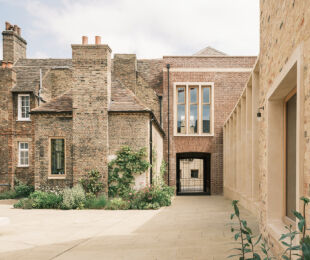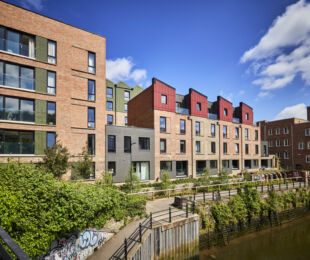
Shrewsbury Flaxmill Maltings is one of the most important buildings of the industrial revolution. A heritage site of international importance, the complex consists of eight listed buildings including the impressive Grade I listed Main Mill, which was the first multi-storey cast iron framed building in the world, widely considered to be the forerunner or ‘grandparent’ of the modern skyscraper.
Built in 1797, the Main Mill originally operated as a steam-powered flax mill until 1886. The complex stood empty for a decade before conversion to a maltings in 1897. During the first and second world wars, the building served as a temporary barracks before being returned to use as a maltings until its eventual closure in 1987. The site then fell into decline before being bought by Historic England in 2005 with a view to restoring and converting the Flaxmill Maltings site into a mixed-use development.
The proposals by Feilden Clegg Bradley Studios, Strategic Advisors and Architects to Historic England provided an exemplar of how modern technology and engineering innovation can be applied to heritage buildings, complementing and preserving their special character.
A light touch conservation approach has been adopted in order to preserve and enhance as much of the special industrial character of the buildings as possible, using traditional crafts, materials and skills throughout. One of the most remarkable features of this restoration has been the making of bespoke oversized handmade ‘Great Bricks’, which at 93 x 230 x 100 mm are approximately one third larger than today’s standard-sized bricks.
As the historic building had originally been built soon after the 1784 tax on bricks was introduced to raise money for the wars in the American colonies, larger bricks had been used to reduce the number of bricks required and consequently the amount of tax to be paid.
Working closely with Historic England and building contractor, Croft Building & Conservation, Northcot Brick was tasked with making handmade bricks to replicate the exact sizing, and the idiosyncratic variation of tone and texture of the naturally aged bricks. These were chosen from a range of shades to suit the Grade I listed Main Mill, Grade II listed Kiln and a number of individual locations around the site.
For the exterior of the buildings, Northcot’s Brickfield Antique was significantly weathered to match the originals, which had darkened with exposure to the elements. On the inside, Brickfield Orange facing bricks, which have a raw clay colour in light and medium shades, proved to be a natural match requiring little modification.
As the original 220-year old bricks had been laid in lime mortar, many were salvaged and used alongside Northcot’s handmade bricks. Both were then laid in a similar lime mortar mix to ensure their sustainability and recyclability in the full expectation that the bricks could potentially last for a further 220-years. During the course of the restoration, Northcot supplied over 37,000 handmade 93 x 230 x 100mm ‘Great Bricks’ for the repair of the facades, and 6,500 bespoke ‘squint’ bricks for the window reveals. A further 34,600 heavily weathered Stratford Antique handmade and machine-made artisan bricks were also made for the boundary walls and other areas round the site.
The Main Mill and Kiln at Shrewsbury Flaxmill Maltings will start to open from autumn 2021 and will feature four floors of commercial working space. In 2022 a café and a brand new visitor experience will open to members of the public, allowing the story of Shrewsbury Flaxmill Maltings to be shared with generations to come.






